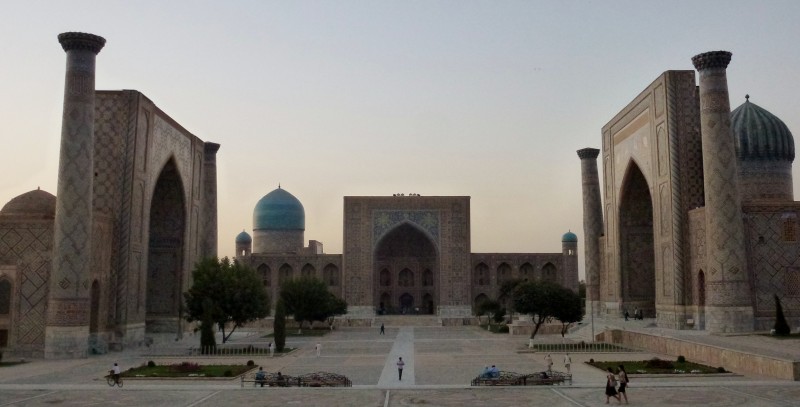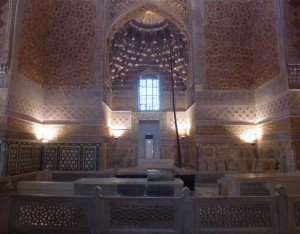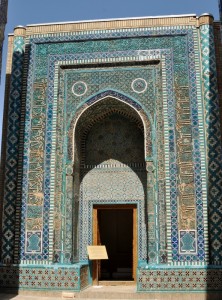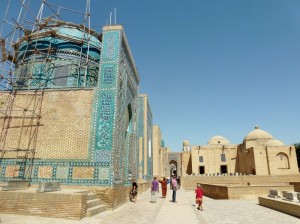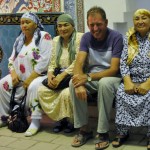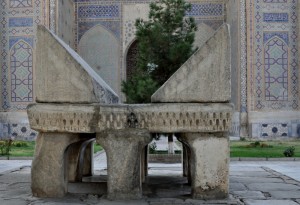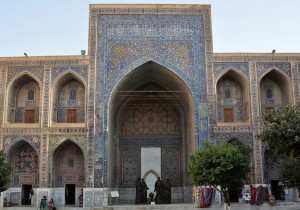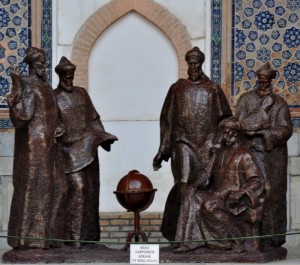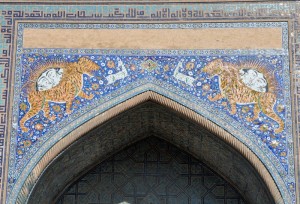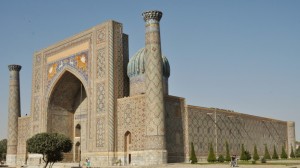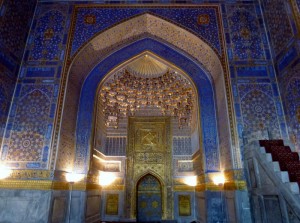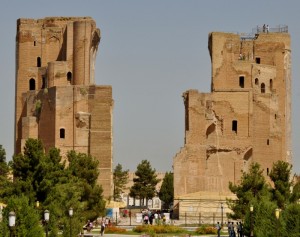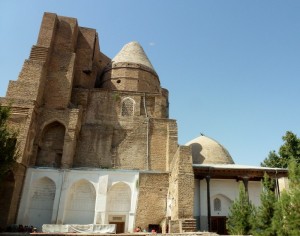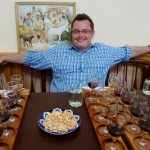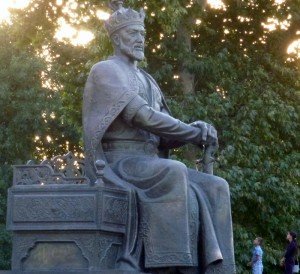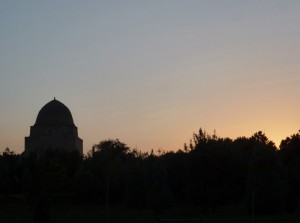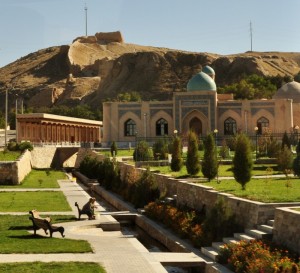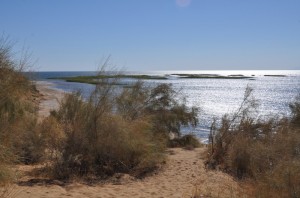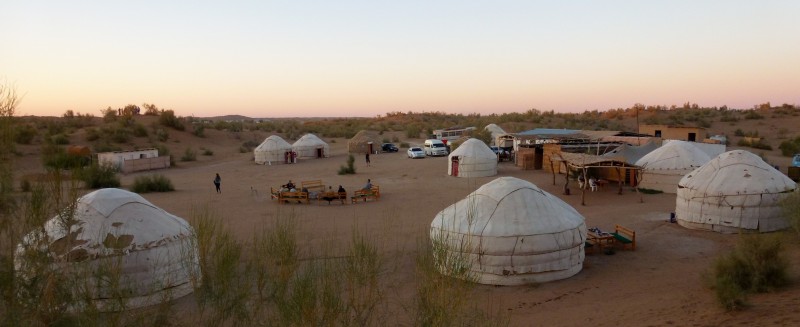Day 18 (August 12): Samarkand (40km)
Samarkand,one of Central Asia’s oldest settlements with over 3,000 years of history, evokes awesome feelings from travellers along the Silk Road for centuries. The city was already cosmopolitan and impressive when taken by Alexander the Great in 329 BC. It sat on the crossroads leading to China, India and Persia. Being swept by history, it was obliterated by Genghis Khan in 1220. Then Amir Timur arrived and made Samarkand the capital of his empire. Under Timur and Ulughbek (Timur’s grandson), Samarkand emerged as an almost-mythical city, Central Asia’s economic, intellectual and cultural epicenter.
When the Uzbek Shaybanids came in the 16th century and moved the capital to Bukhara, Samarkand went to decline. It further suffered from a series of earthquakes in the 18th century. The Russians came in 1868 and brought the city back to life. Samarkand was the capital of the Uzbek SSR briefly from 1924 to 1930. It remains the second largest city in Uzbekistan with a population of half a million.
We had a fantastic sight-seeing day. The splendid and magnificent architecture and buildings in Samarkand are the work of Timur, Ulughbek and the Uzbek Shaybandis.
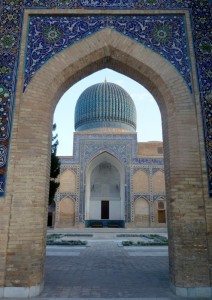 |
Our first stop was the grandiose Guri-Amir Mausoleum with a fluted azure dome. Timur had built this for his sons and grandsons and a simple crypt for himself at Shakhrisabz. When Timur died suddenly of pneumonia in Kazakhstan in 1405 and the passes to Shakhrisabz were snowed in, he was interred here instead. The hall is impressive with Timur’s stone (a single block of dark-green jade) in the centre surrounded by his two sons, two grandsons including Ulughbek and two teachers.
The next stop was the Ulughbek Observatory. Ulughbek was a famous astronomer and had built an immense (30m) astrolab for observing star positions in 1420s. The three -storey observatory has long gone but the instrument’s curved track was unearthed in 1908. The display in the museum including a model of the observatory, pictures of instruments, achievements and publication of Ulughbek, is however not impressive.
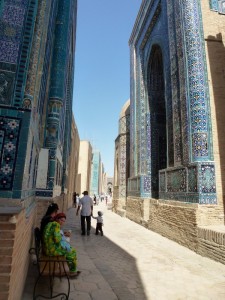 |
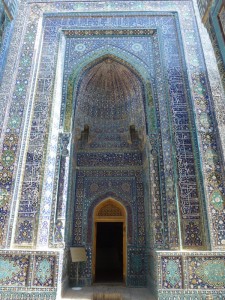
|
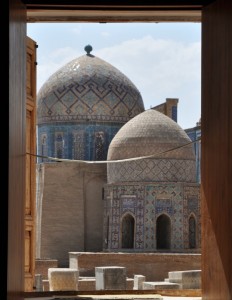 |
The third stop at Shahr- I-Zindah (Tomb of the Living King) was a nice surprise as I had not seen any images of this amazing site before the visit. The first and most important shrine is the grave of Qusam ibn-Abbas (the Living King), a cousin of the Prophet Mohammed who is said to have brought Islam to the region. This holy shrine is an important pilgrimage site for Uzbeks. Shahr- I-Zindah took on its present form in the 14th century when Timur and his descendantsburied their family and favourites near the Living King. The mosaics in all sorts of blue hues and patterns are impressive. This avenue of mausoleums has the most exquisite and beautiful un-renovated glazed tilework in Central Asia.
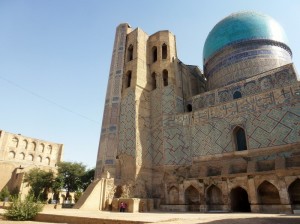 |
After a lunch in the bazaar, we went to see the enormous Bibi Khanym Mosque which was finished shortly before Timur’s death. It was not well built: it started to crumble shortly after completion and finally collapsed in an earthquake in 1897. Though the main gateway and several domes
have been restored, the inside stripped of the mosaics looks ghastly. In the courtyard, there is an enormous marble Quran stand. Local women crawl under it in order to have lots of children.
Our final destination of the day was the Registan which is the landmark of Samarkand. There are three majestic, tilting medressas namely the Ulughbek Medressa (1420), Sher Dor (Lion)Medressa(1636) and the Tilla-Kari (Gold-covered) Medressa (1660). The first was built by Ulughbek who was said to have taught mathematics there) and the last two by Shaybanid Emir Yalangtush.
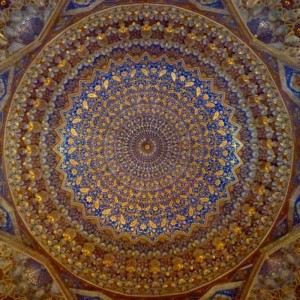
|
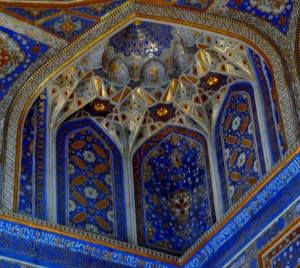 |
The group had dinner at another local restaurant with live music. I enjoyed the relaxing and joyful atmosphere. My dinner with beer and plov only cost me 16500som.
Day 19 (August 13): Samarkand – Shakhrisabz – Samarkand (160km)
Robert, Dawn, Hortensia and I shared a taxi (UD$50) to Shakhrisabz, Timur’s hometown where he was born on 9 April 1336. It has several monuments associated with Timur.
I started off my self-guided walking tour at 10:30am at the foot of a gigantic statue of Timur which was probably the centre of the Ak-Saray Palace built by Timur in 1379. Today, only the ruins of the palace with a 40m-high pishtak covered with unrestored mosaics are still standing. I climbed 115 steps to the top to take a bird’s eye view of the town which is dotted with ruins and brownish and mud houses. It has retained its original town planning with a rural appearance and atmosphere.
 |
I then walked with Hortensia to see the Kok-Gumbaz Mosque (a Friday mosque completed by Ulugbek in 1437 in honour of his father Shah Rukh). Behind the mosque is the Dorut Tilyovat (House of Medication) with two blue domes. On the left is the Mausoleum of Sheikh Shamseddin Kulyal completed in 1374 (he was spiritual tutor to Timur and his father). The other one is the Gumbazi Seyidans (Dome of the Seyyids) which Ulugbek finished in 1438 as a mausoleum for his own descendants.
A few hundred metres away is the remnants of a 3500-square-metre mausoleum complex called Dorussiadat (Seat of Power and Might) finished by Timur in 1392. The Tomb of Jehangir, Timur’s eldest son who died at 22 is still standing. Nearby is a very small underground room known as the Crypt of Timur. I did not feel comfortable and flee within a couple of minutes.
We had a light lunch with soup and samsa (a pastry with minced meat and onion) at a street stall. I went to see a museum housed in the renovated Chubin Medressa. We left at 2pm to return to Samarkand.
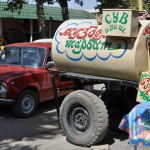 |
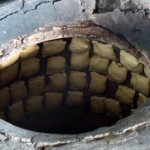 |
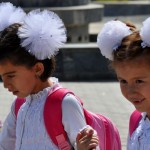 |
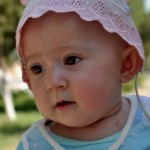 |
At 4pm, the group left for wine-tasting for 15000som each. I was given ten glasses of wine. I find the wine too sweet and did not finish the wine, which is just as well because after ten glasses even an Australian would be inebriated. Anyway, we had lots of fun.
I took a walk to see Timur’s statue on a throne, Rukhobod (Timur’s teacher) Mausoleum (1380) and the Guri-Amir Mausoleum. I went to a B&B in the old town and had an excellent home-made plov with salad and tea for three dollars! I met Teresa and Josephine from Japan who were travelling on their own in Uzbekistan.
Day 20 (August 14): Samarkand –Nurata –Lake Aidarkul (260km)
The truck was back on the road at 9am. Our cook group (Dawn, Helen, Jackie and I) had to shop for lunch in a small town on the way. We brought plenty of fresh cucumbers, tomatoes, red pepper, cheese, salami, bread and melons.
The scenery changes once we hit the Kyzylkhum Desert. We arrived in Nurata and had a quick lunch before visiting the fortress of Alexander the Great built by his army. Only a castle remains looming over the town. Beneath the fortress and next to a mosque is the Chashma Spring where hundreds of ‘holy’ fish (trout) live off the mineral-laden waters of the spring and canals.
The road is not bad and we arrived around 5pm at a yurt camp close to Lake Aidarkul, an artificial lake formed from the diverted waters of the Syr-Darya in 1969. All guests at the yurt can have a ten-minute free camel ride. I had a leisure walk to see sand dunes and sunset.
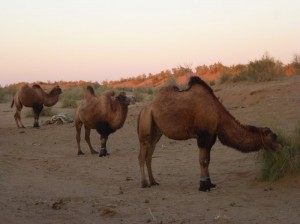 |
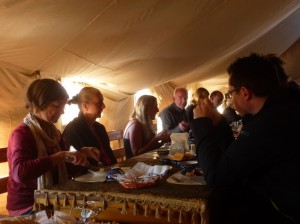 |
The camp is well equipped with two dining tents, toilets and shower cabins. I had a shower before dinner. There were over 40 tourists that evening. We sat around a fire when a local singer sang for us. The music is soft and his singing is moving. I had a fairly good sleep in a bed in the yurt.
Day 21 (August 15): –Lake Aidarkul – Navoi –Burkara (205km)
We had a leisure morning. After breakfast, we went to the lake to spend the next two and a half hours.The lake is not particularly beautiful but with a cloudless blue sky, weeds, soft golden sands and undulating sand dunes, it is picturesque.
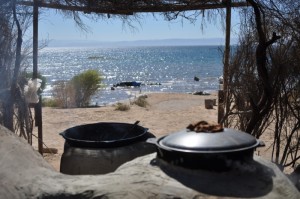 |
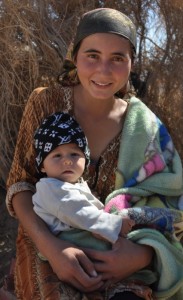 |
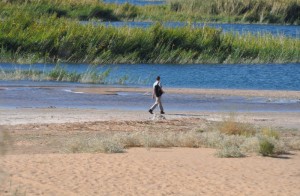 |
I walked along the lakeshore and spent half an hour with a family living by the lake. Their open-air kitchen is awesome with a huge oven for baking and two for cooking. The lady of the house is 54 and looks majestic. She has four children and is surprised that I am single without children. She was cooking tomatoes, potatoes, onions and sausages in a big pot and offered me to try the food. Her daughter-in-law with a one-year-old baby and is most beautiful.
I had a quick swim before returning to the yurt. The lunch with fish was delicious. It was the first time I had fish since arriving in Bishkek almost a month ago. I miss seafood and shall eat fresh fish on my return to Hong Kong.
We set off after lunch and arrived in Bukhara just before 6pm. On the way, we had a brief stop to look at a 15th century caravanserais and a spring in Navoi.
I had dinner at the Lyabi-Hauz, a plaza built in 1620 around a pool surrounded by mulberry trees. I had a beer and a small bowl of noodle soup for 14500som. Not very cheap!


